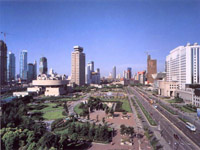China’s sweeping economic reforms, which have lifted the country to a starring role in the global economy in only a quarter-century, are marked by a more gradual transition from state control to private ownership of firms than in other countries that have also made the transition, according to Wharton faculty. At the same time, a vibrant, entrepreneurial private sector is springing up in China alongside state-controlled firms.
“Privatization in China … still leaves a huge residual of state influence,” says Wharton management professor Marshall Meyer. “The role of the state in China can never be underestimated.”
After decades of state control of economies in China and other nations around the world, governments set off a wave of privatizations that began in the late 1970s. Often pressured by the U.S., these governments realized that industries run for political gain were losing ground in the global economy. Economic growth was stalled and living standards were not improving.
The wave of privatization began in Chile and the United Kingdom and spread around the world with major programs in the former Soviet Union, Eastern Europe, Latin America and India.
In China, privatization has come slowly as government officials weighed the prospect of massive layoffs necessary to restructure bloated state-owned enterprises, known as SOEs. Privatization was also met with resistance from influential company managers, many of them Communist party officials.
The number of SOEs has been cut to just 15% of all industrial firms — from 114,000 in 1996 to 34,000 in 2003 — with about half of the decline due to privatization. The remaining state-owned firms, however, are among the largest in China and include more than half the country’s industrial assets, according to a 2005 report by the International Finance Corporation (IFC) of the World Bank titled, China’s Ownership Transformation.
Wharton legal studies professor Philip Nichols points out that maximum profitability is not necessarily the only goal of Chinese government officials’ privatization efforts. “One of their objectives is to maintain the supremacy of the party. Obviously there’s a tension between that and creating a market, which is essentially a democratic process spreading out power among the people.”
China is unusual among countries undergoing privatization because it has allowed many of its state-owned firms to continue to exist while an emerging private sector economy creates new companies from the ground up, Nichols states, adding that “privatization occurs in all kinds of hybrids. The Chinese model is that you grow a private sector at the same time as you maintain the state-owned enterprises. If the state-owned enterprises can’t compete with the private sector, then they are allowed to wither away.”
Mixed Models
The Chinese government has used a variety of models to spin off state companies, according to Wharton marketing professor John Zhang. One method has been to sell shares of state-owned enterprises through public stock exchanges that were created in the early 1990s. After a frenzied boom in Chinese stock markets, share prices have suffered through a long slump, primarily because most of the stock in listed firms remains in government hands.
Another model used in China is to sell shares to managers in the firms. The IFC survey found that in sample firms, insiders held 5% of privatizing firms’ shares in 1996, but by 2002, insider stakes were up to 32%.
In many critical industries, the government retains a significant share. “Right from the beginning, the Chinese government drew a line in the sand saying it would control the strategic sectors — energy, transportation, basic commodities,” says Zhang. In the end, he adds, the government will still retain control over the economy and the Chinese people.
Meyer estimates that private ownership will — at most — move from 30% of GDP to somewhere between 40% and 60% because of the government’s determination to retain controlling stakes in key businesses. He suggests the government will always remain in control of the 100 largest firms in China.
Meanwhile, privatization has slowed in the past year as the government has come under criticism for attempting to benefit politically influential insiders. “There has been a big debate over this,” says Zhang. “There are concerns that people will use the privatization process to enrich themselves.” The dispute concerns whether to provide additional compensation to current shareholders, many of them influential families and politicians, if the state dilutes the shareholders’ holdings through the sale of additional stock. “This is extremely controversial and lots of Western people are objecting very strongly,” says Meyer. “In effect, the Chinese are paying off existing shareholders to list additional state shares.”
Another interim step in privatization was the central government’s transfer of state assets to local jurisdictions, where the companies became known as Town and Village Enterprises (TVEs), says Wharton management professor Gerald McDermott. “What’s clear is the traditional SOEs, which were mainly owned by the central government in heavy industry, have done really badly, but it was the TVEs that have done quite well.”
Meyer says China is attempting to move toward a model adopted in Singapore where Temasek Holding Pte. acts as a government holding company that invests and manages state-owned assets. Temasek, which means “Singapore” in the Malaysian language, holds stakes in businesses including Singapore Airlines, Singapore Telecommunications, DBS Bank (the country’s largest bank), and Raffles Holdings, the resort company. It also has investments abroad in ICICI Bank in India, China Construction Bank in China and Quintiles Transnational Corp. in the United States.
Poor Performers
In China, the State-owned Assets Supervision and Administration Commission (SASAC) was formed in March 2003 to manage the assets of the nation’s largest companies and is moving toward becoming a holding company for China’s investments.
A major obstacle to the privatization of additional Chinese companies is that many of the ones remaining in state hands are poor performers. Forty percent of the state-controlled firms are losing money, compared to 18% of firms in the non-state sector, the IFC found. “China has to put the state-owned assets on a sound footing,” says Meyer. “They continue to be drained by the government.” Government statistics showing state-owned businesses are profitable shroud the truth that most of the profits are made by a handful of companies, particularly those in the telecom sector, which enjoys monopoly protection, he notes.
Meanwhile, a private economy is growing up on the strength of smaller, less capital-intensive industries, such as auto parts and garment manufacturing. Meyer points to TCL Corp., a manufacturer of fans and home appliances founded in 1981 that now has revenues of $6.6 billion. “There are all kinds of private enterprises popping up. The difficulty is they don’t have much access to bank loans or capital markets.”
The situation isn’t helped by the fact that the Chinese stock market, after an initial upsurge in the early 1990s, has been in the doldrums, says Meyer. Chinese share prices have declined 15% since 2002 — making China the worst performer of the top 25 markets and the only one to lose value over the period. Concerns about weak capital markets are leading top Chinese companies to list abroad, mostly in Hong Kong, with the blessings of the Chinese government. Expansion of the private sector, Meyer notes, also continues to be constrained because private property is not protected under the Chinese Constitution.
Russia’s Bad Example
China’s privatization process differs from that in Russia and many countries in Eastern Europe that engaged in rapid “shock” privatization by distributing state assets to the population through massive voucher programs in the 1990s.
Wharton finance professor Bulent Gultekin, who oversaw government privatization programs in Turkey and Poland, says China is moving at a slower pace than many other countries because it is haunted by the experience of the former Soviet Union, which slid into economic malaise after the collapse of its Communist system and its state-controlled economy. “The Soviet Union was a mighty empire. Now Russia is a second or third-rate power with nuclear weapons,” says Gultekin. “That hasn’t played well in Russian society and it’s a great lesson to the Chinese leaders.”
The threat of societal breakdown and a collapse into civil war has consumed Chinese leaders for centuries, and today’s Communist leaders are no different, he says. As a result, they are willing to proceed slowly with the transformation to private ownership of state-controlled assets.
Chinese government figures indicate that 30 million people have been laid off at state-owned enterprises and more than 8 million have been unable to find new jobs. “The Chinese are trying to manage that politically. I think it’s a sensible thing to do because China is much more populous than the Soviet Union,” says Gultekin. “Managing the change in itself is a challenge. The Soviet Union wasn’t able to do it.”
According to Gultekin, the dual-track development of China’s private sector could be a successful model for the Chinese. “It’s happening sort of spontaneously. China has effectively built a market economy … with some state sectors that eventually might phase out.”
Meyer notes that long before the Communists came to power in China, the country had a history of blending private and public economic entities, a tradition that is common in other rice-growing regions of Asia. To grow rice, villagers need central control of water and terracing systems. “China has a deep tradition of bureaucratic capitalism,” he says. “It goes back thousands of years.”
A Gradual, Rather than Swift, Transition
Wharton management professor Mauro Guillen says academics examining privatization often debate whether a speedy transition is better than a slower, gradual model. “The Chinese have taken the second option and there’s no doubt in my mind they should do it gradually.” He points out that a rapid sell-off of troubled companies can lead to low valuations for the citizens of the state who are, in effect, the owners of the firms.
Shares in a firm that is in strong financial shape can be sold off in stages, he suggests, while a poorly run company could be restructured or held until it can get a better price.
Fast or slow, merely changing the ownership of a company is not a guarantee of success in any country, particularly a developing nation like China, where financial institutions, such as a regulatory agencies and capital markets, are weak. “What the Chinese have to worry about is the regulatory structure,” says McDermott.
Insolvent, but Liquid
Another concern is the banking system. The Chinese government has announced it will continue to hold majority stakes in three of its four biggest state-owned banks for at least another decade. The nation’s banks have been selling shares to outsiders, but they remain weighed down by huge portfolios of non-performing loans.
McDermott says China needs to create mechanisms to finance development other than banks. “They have to balance between banks that are really stable and banks that help finance development, or they will have to develop different financial institutions.”
China, adds Meyer, can afford to go more slowly with bank privatization because the banks are sitting on piles of cash deposited by Chinese savers who are prohibited from converting their currency to make investments in other countries. “The Chinese banks don’t need the money. They’re insolvent, but liquid as hell. All this money is trapped in China.”
As China moves forward, Nichols predicts it will be difficult for the country to sustain its two parallel economies. “With the Chinese model, you have to have a lot of money,” he says. “China’s wealth is illusory because it is spending a lot of that wealth. Maintaining two economies — the private and the state-owned — might be a little too much of a burden for them.”
Meyer predicts that smaller, private Chinese companies will continue to grow faster than the country’s large state-owned industries and will leapfrog over the big companies to become players in the international economy. In most economies, he adds, it is only large, mature firms that have the resources to go international. But in China, because of the lack of strong financial institutions, it may be easier for small companies to move offshore earlier. “I think companies at a very early stage will internationalize,” Meyer says.



